Photographs: Reuters Colonel Anil A Athale
Colonel Anil A Athale outlines the contours of the coming Sino-Indian conflict in East Asia. The first of a two-part series.
Quietly and without much fanfare in the Indian media, India's 'Look East' policy has been operationalised.
The visit to Laos and Cambodia by President Pratibha Patil, though largely symbolic, was the first in more than two decades. Closely following her is Prime Minister Manmohan Singh's visit to Japan, South Korea and Vietnam.
These developments are taking place in the backdrop of increasing Chinese assertiveness vis-a-vis their claim of the South China Sea islands (reportedly rich in oil), clash with Japan and strident claims on the Indian state of Arunachal Pradesh.
These diplomatic moves come in the midst of regular Indian naval exercises in the South China Sea and visits to ports in Vietnam.
Public debate, such as it is, on the long-term Chinese threat to India has been dominated by the theory of Chinese 'String of Pearls' strategy. For long, Indians have been aware of the Chinese string of naval facilities round Indian Ocean region.
...
Chinese have ill chosen their allies
The Coco Island, north of the Andamans and belonging to Myanmar(Burma) is long thought to be a Chinese naval base.
To the south, in Sri Lanka, the Chinese have been building a deep-sea port at the southern tip at Hambantota.
The Hambantota port has no economic rationale and is clearly a naval facility. The last of the Chinese pearl is Gawadhar port in Baluchistan province of Pakistan.
The Chinese have close relations and alliance with North Korea, Myanmar and Pakistan.
Not unlike the Americans in their heyday, the Chinese have ill chosen their allies. All the three countries have unpopular and unstable regimes and are an economic burden on China.
India, Japan and Vietnam are coming closer
China's largest ally, Pakistan is a bankrupt country torn by internal violence and is a failed state.
As opposed to this, slowly but surely, India, Japan and Vietnam, with American blessings, are coming closer to form a ring of steel around China.
A closer look at the above map shows how China is virtually surrounded by states that are not very friendly.
This author visited Vietnam, Laos and Cambodia for over two weeks recently. The aim of this article is to share impressions from that visit to help Indians understand the region.
First and the foremost, one was struck by the all-pervading presence of Indian culture -- as noticed by behavioural similarities. Be it the greetings, never giving money with just one hand, removing shoes before entering a house, the all-pervasive images of Buddha and even Hindu Gods.
Why 'Secular' Indians would throw a fit in Laos
Image: A Vishnu statue at museum in Kuala LumpurPhotographs: Col Anil Athale
'Secular' Indians would throw a fit to know that the Laos national TV begins with the picture of Ganesha!
But does this mean there is Indian influence or the much-touted 'soft power'?
Unfortunately that is not true. In Vietnam, for instance, when told that we are from India, the guide instinctively said 'So you must be Muslim!'
A co-passenger in a local bus, returning from a visit to a pagoda, confidently informed that Buddha was born in Sri Lanka.
Vietnam, the emerging 'tiger' of South East Asia
Photographs: Reuters
But before one delves into the reality, the good news is that in all the three countries, the mention of China evokes only negative response.
In the popular perception China is an object of dislike, a notch above the Americans!
All these countries have gone through hell in last 50 odd years at the hands of barbaric American forces and later Chinese machinations -- the 1979 Chinese invasion of Vietnam is very much alive in the public memory and of course none in Cambodia an ever forget the murderous Pol Pot regime that was supported by the Chinese!
Vietnam is an obvious military power to reckon with in the region.
But the dedication and single mindedness that the Vietnamese displayed in fighting the Japanese, the French, the Americans and the Chinese, is now transforming the country economically.
In less than a decade Vietnam is emerging as the new 'tiger' economy of South East Asia.
Most ancient kingdoms in the region bear a strong Indian stamp
Image: Po Nagar, built by the Champa near modern-day Nha TrangPhotographs: Petr and Bara Ruzicka/Wikimedia Commons
Ancient Linkages with ndia
The history of Indo-China for a millennium or more is dominated by the struggle between Champa Kingdom based in Malaya, South and Central Vietnam and parts of Laos and Cambodia's Khemer Kingdom with the capital at Angkor Wat, Thailand and the Viet Kingdom of North Vietnam centred around Hueand Hanoi.
These kingdoms crisscrossed the boundaries of modern states of the region. Thus there are significant minorities in each country.
By and large the relationships are harmonious as Buddhism is a binding force.
There were exceptions like when in the late 1970s Pol Pot regime in Cambodia targeted the Vietnamese that led to the invasion by a unified Vietnam.
Of these ancient kingdoms, culturally, except for the Viet Kingdom that was closer to Chinese, the rest bear a strong Indian stamp.
Hinduism arrived here not from India but from Java
Image: Wat Pu temple in Champaksang province of Laos dates back to 8th centuryPhotographs: Col Anil Athale
Interestingly, Hinduism came to these parts not directly from India but from Java island of Indonesia.
The kingdoms of Champa and Kamboj find mention in the Mahabharat and Bhagwat Purana.
Similarly, Buddhism, that is the dominant creed in today's Vietnam and Laos, reached here from China, and not India.
The Champa kingdom of central and south Vietnam was established in 2nd century AD (around 400 years before the advent of Islam and birth of Prophet).
Champa Kingdom was a maritime power and dominated the trade between rest of Asia/Middle East and China. Indrapura was near modern Hoi An.
Champa kingdom lasted for nearly 1,600 years
Image: Cham statue from Cham Museum in Danang, VietnamPhotographs: Magnus Manske/Wikimedia Commons
Nearby My Son Valley bears the highest number of Champa ruins.
Amaravati was in modern Quang Nam, Vijaya is modern Cha Ban while historical Kauthara became modern Nha Trang, the only one of these cities that retained some importance.
Finally, Panduranga is now called Phan Rang. The relative importance of each city varied along time; invariably they became tourist attractions offering awesome nature views and historic sights.
Afterwards, what remained of Champa was the southern principality of Panduranga.
In 1594, the Cham Lord Po At assisted the Sultanate of Johor's attack on Portuguese Malacca; and in 1692, the Cham Lord Po Sot rebelled against Nguyen Phuc Tran, ruler of southern Vietnam.
After that, the Cham Lords kept authority over their own people but not over Vietnamese settlers in their territory. This situation was kept until 1832 when the Cham territories were finally annexed by the Vietnamese. The Champa kingdom thus lasted for nearly 1,600 years.
An Indian feels totally at home in Vietnam
Image: The golden age of the Khmer civilization was between the ninth and thirteenth centuries, when the kingdom of Kambuja, which gave Cambodia its name, ruled large territories from its capital at Angkor in Cambodia's west.As the initial Hindu civilisation gave way to Buddhism, the idols in most temples were replaced by Buddha statues.
But the Buddhists, however, did not indulge in vandalism and the rest of the temples and statues remain intact.
An Indian finds Vietnamese culture so similar to Indian that one feels totally at home.
The Khemer kingdom in Cambodia is well known the world over for its grand architecture and still surviving wall panels. Cambodia went through a Hindu phase from 2nd century AD followed by a Buddhist phase from 6th century and again a brief Hindu revival in 11th century.
But 13th century onwards, Buddhism holds sway there.
But shared history mean nothing but a distant memory for most people
Image: A scene from Ramayan. Hanuman is a popular figure among Combodians. He is admired for his valour and devotion.Photographs: Col Anil Athale
The stories of the Ramayan and Mahabharat wars are depicted on a panel in the Angkor Wat main temple that was dedicated to Shiva. It is possibly the biggest Hindu temple in the world.
Cultural similarities, religious affiliations of the past and even shared history mean nothing but a distant memory for most people.
To be truthful, to most south east Asians it is of irrelevance. These factors can be converted into 'influence' and soft power only with cultural, economic and social linkages.
In the past, the India link withered away as India itself was locked in a life and death struggle with Islamic invasions. The coastal trade from Bengal (Dacca) and Orissa had come to a virtual standstill.
It is the takeover of the sea trade by the Arab seafarers that brought Islam to these parts.
More Hindu than Muslim in ethos
Image: Buddhist monks in front of the reflection pool at Angkor Wat, Cambodia.The conversion to Islam was a peaceful process and not a result of invasions or wars.
Thus while the Malays and Indonesians became Muslims, they nevertheless retained their ancient culture.
A chance remark by an Indonesian was that while we have been Muslims for a few hundred years, we have been Hindus and Buddhists for several thousand years.
This attitude to pre-Islamic culture and history is in direct contrast to what has been happening in the Indian subcontinent and westwards, where the Bamiyan Buddhas had to succumb to Taliban rage few years ago, Kashmiris deny Lalitaditya, Avantiverman and even Sultan Zain Ul Abadin!
Watch this space for Part II
Col Anil Athale is the co-author of official history of Sino Indian War 1962 and coordinator of the Pune-based think tank Inpad.

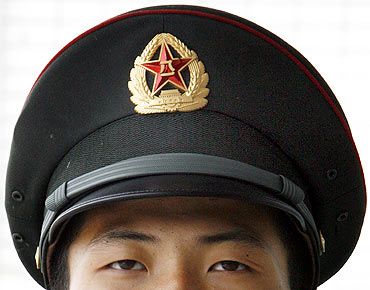


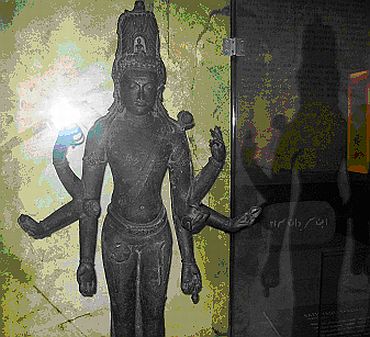
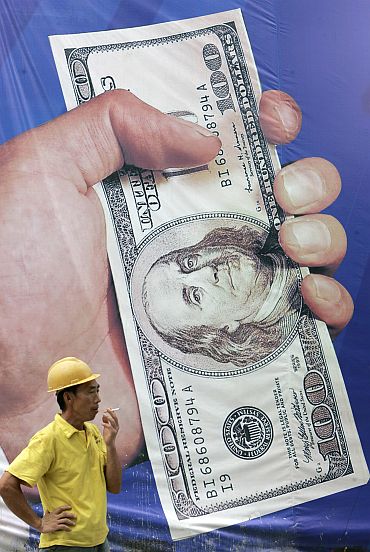


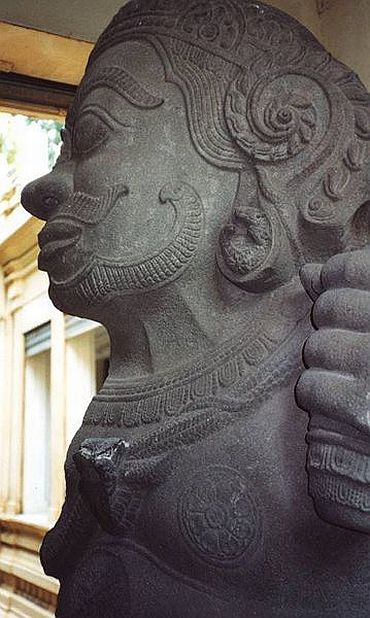


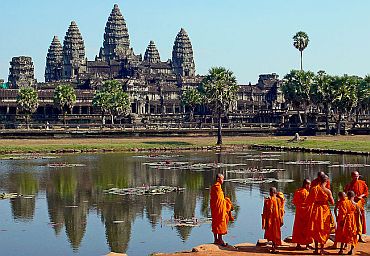
article